That’s right, everyones favorite navigation app can also be a valuable asset to the carp angler, and all anglers alike. According to Wikipedia, Google Maps is the fourth most popular app in the United States, and with good reason. It’s your trusty sidekick, your guide to the unknown, and if you end up lost, it’s your North Star. Something Google Maps isn’t necessarily designed to do, however, is to help us anglers find our next swim, and to assist us with gaining the knowledge needed to better access, and approach these new swims, which it very much does. Here are three simple ways you can better utilize Google Maps as an angler.
1. Find access points
So you’ve noticed a local body of water that screams carp, but there’s one small hurdle you’ll need to overcome. How do you get to the water? Public access points? What if there are none? Well, aside from searching for marked locations on the map like public boat launches, fishing access, and so on, you can use Google Maps satellite view to do some in-depth investigating, and find those precious, quiet, isolated swims we all love.
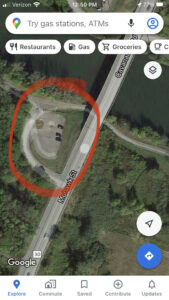
You’ll want to start by identifying the water you’re trying to explore. Scan the shoreline and look for unmarked access roads and pull-offs. You’ll likely be intrigued by your findings. I’ve fished a few local waters near me with unknown access points right under my nose. Some of which have produced some stunning fish since discovering.
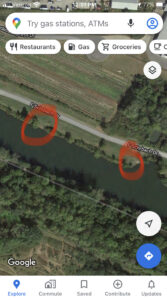
Things like tire marks in the grass and worn out spots near the waters edge are dead giveaways that people fish that spot, and that it’s likely accessible.
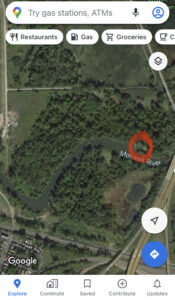
Here is a perfect example of a spot near me that took a while to find. It’s quite difficult to access and I haven’t fished here yet it but it certainly has potential. From the sky it’s hard to see much of anything..
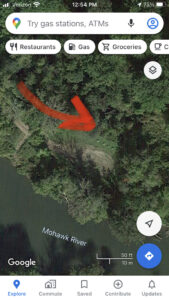
…but upon further inspection I noticed a spot that appeared to be a parking area with a few large rocks clearly placed intentionally. After scanning the map I found an unmarked access road leading in the direction of the parking area. Naturally, I dropped a ping on the map and made plans to attempt to visit this carpy looking swim at a later date, which brings me to my next tip.
2. Save pinged locations and take notes
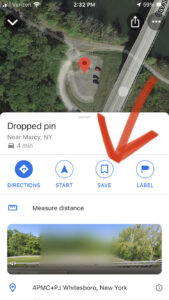
It’s important while you’re finding these new spots that you drop a ping and save the locations before moving on. Otherwise you may find yourself wasting time scanning the map again later and losing track of which one was where. The only thing you need is a Google account to access this feature. Simply tap the location you want to save to drop a ping and the above options become available.
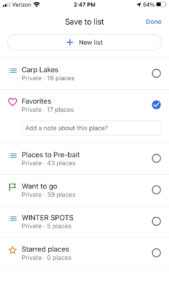
From here just click ‘save’ and you’ll be prompted to a menu asking which list you’d like to save your ping in. You can use an existing list such as “Favorites” or “Want to go”. Or simply create a new list titled however you feel appropriate. This will give you the option to leave some notes about the swim as well which really comes in handy before and after you’ve physically been there. Tip number three talks about one of the most critical variables to take note of when fishing any swim, structure.
3. View structure you can’t see from shore
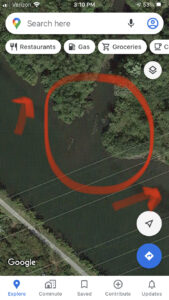
Incredibly, given the right circumstances, you can see an unbelievable amount of structure in the water using the satellite view on Google Maps. Structure such as fallen trees, weed beds, sand flats, changes in depth, inlets/outlets, the list goes on. This is wildly beneficial to us carp anglers because it can give us an idea of what we may be getting ourselves into before we even cast our first lead to feel out the bottom. Also, it can lead us to more remote swims such as ones only accessible by boat. You can spend hours mapping out places to visit in the future, and if you live in an area where winter forces you away from the bank for a few months, this is a great way pass the time and hype yourself up for what’s possible come spring. As you’ll see below, I’ve spent quite a bit of time mapping out swims across my entire home state of New York.
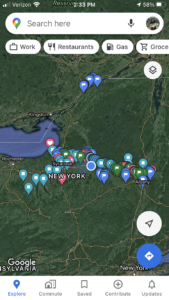
So while you’re trapped inside with cabin fever pull out your phone and get to searching! You never know what may be right around the corner teeming with massive carp waiting to be caught. But most importantly don’t forget to take action on those findings come spring and get out on the bank!
Thank you for reading, Tight lines everyone!

